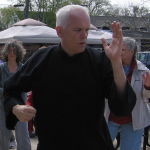[Meditation in Motion]
Taiji and Meditation
Eric Borreson
 Taiji is often discussed as a meditative practice. Meditation does not mean the same thing as relaxation. It does not mean achieving a state of blissful calmness. Meditation is all about intention and focus. With practice, we can develop a calming focus to our movements. However, that calm focus does not come easily. Our mind resists it all the way.
Taiji is often discussed as a meditative practice. Meditation does not mean the same thing as relaxation. It does not mean achieving a state of blissful calmness. Meditation is all about intention and focus. With practice, we can develop a calming focus to our movements. However, that calm focus does not come easily. Our mind resists it all the way.
There are two aspects of our mind that are involved in our practice. The first aspect of our mind is the heart mind (Xīn, 心 脏 ), or “monkey mind.” This is the active, emotional part of our mind. It is the part responsible for the random thoughts that distract us during our practice. This part of the mind is very strong in beginners and is the cause of considerable emotional stress.
The second aspect is called the one-pointed mind (Yi, 意 ), or intention. This is the part of the mind that pays attention to the fine details of the movement. It notices the opening and closing of the kuas, the slow shifting of our weight, and all the other fine points of our movement. This part of the mind may be very weak in beginners. It can be strengthened through practice.
One of the goals during practice is to use our intention to calm down the “monkey mind” and to focus on the movement. This is a form of meditation. Meditation is much more difficult that it would appear. A lack of focus is something that all taiji practitioners must deal with at some point. In fact, it can be quite frustrating to deal with a wandering mind during forms practice.
One way to deal with “monkey mind” during forms practice happens during repetition in the form. We should not simply be moving through the forms. We should be focusing on our movement. The sets are sometimes designed with extra repetition of some of the forms. The individual forms in a sequence may be repeated, but the sequence of the following forms may be different.
It is easy to reach a point where our minds forget where we are in the sequence. It takes focus and intention to keep track of where you are in the sequence and what comes next. With practice, the practitioner can focus on all the forms during a set.
For example, the Sun 73 set that I usually practice includes 7 Single Whip movements. Each repetition is followed by a different form. Each repetition is an opportunity to lose focus and fall out of sequence. This serves as a reminder that focus is necessary. The forms sequence can only be completed correctly when the intention is there and the “monkey mind” is under control.
The regular repetition of the Open Hands and Close Hands provides some extra help. Each time we pause for these forms, we have an opportunity to pause, recenter, and refocus. As we develop in our practice, we learn to tame the “monkey mind.” This makes our practice a form of Meditation in Motion.
Eric Borreson – a student and teacher, finds teaching taiji, qigong, and meditation to be a path to a more meaningful life. Eric is the founder and director of Meditation in Motion, specializing in teaching about living healthier and happier lives. He teaches taiji, qigong, and meditation at the prestigious Heartland Spa, a top 10 destination spa, located in Gilman, IL. In addition, he teaches taiji (Yang 24, Sun-style taiji, and Dr. Lam’s Taiji for Arthritis and Taiji for Diabetes) at other venues. He conducts workshops and teaches private lessons on request. He writes a weekly wellness column at http://eric-taichi.blogspot.com.


One Response to Meditation In Motion – Taiji and Meditation